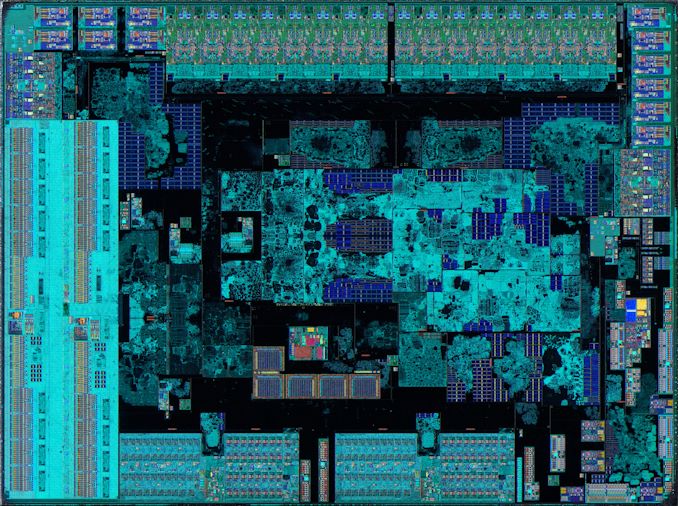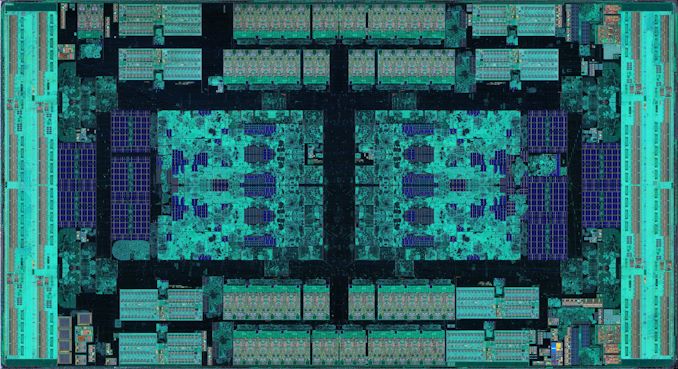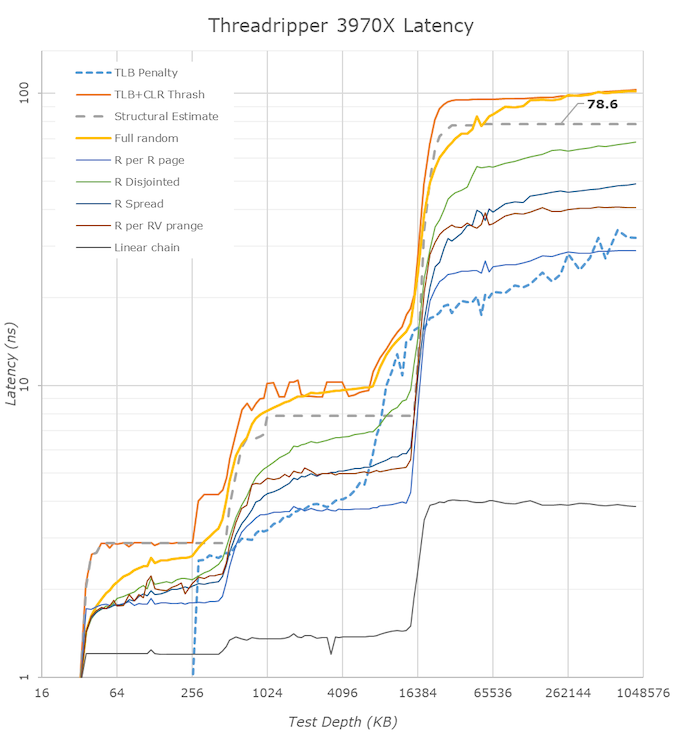The AMD Ryzen Threadripper 3960X and 3970X Review: 24 and 32 Cores on 7nm
by Dr. Ian Cutress, Andrei Frumusanu & Gavin Bonshor on November 25, 2019 9:05 AM ESTZen 2 Platform for HEDT - Improvements over Last-Gen
Section by Andrei Frumusanu
The platform architecture of the new Threadripper 3000 series is fundamentally different, and a massive departure from what we’ve seen in the past on the first and second generation Threadripper products. Previously, AMD still made use of its monolithic die design used in Zen and Zen+ Ryzen, Threadripper and EPYC products. The approach was an economically smart one for AMD in regards to having to design only a single silicon die that would be used across the three product lines, however it had some fundamental technical disadvantages when it came to power efficiency as well as having to make some performance compromises.
The biggest disadvantage exhibited by the Threadripper 2000 series was the platform’s weakness in regards to its memory architecture, an issue that was particularly prevalent in the 32-core Threadripper 2990WX. As explained in our review of the TR2 products last year, the main problem with that SKU was that in order to achieve a 32-core product, AMD had to make use of 4 “Zeppelin” dies. Unlike the server-oriented SP3 socket however, Threadripper products come on the TR4 platform. While the two sockets are physically identical, they’re electrically incompatible with each other. In practice, the biggest difference between the two platforms is the fact that Threadripper products supports 4-channel memory setups, while the EPYC variants support the full 8-channel memory configuration possible.
The main conundrum for a product such as the 2990X which had to make use of 4 dies, each integrating 2 memory controller channels, is the decision on how you split up the memory controller setup between the dies and choose which 4 active controllers you’ll end up using. AMD’s approach here is that instead of using only one memory controller per die, the company chose to have two dies each with both memory controllers active, while the other two dies wouldn’t have any memory controllers enabled at all. The issue here is that the CPUs located on these dies would only have to access memory by hopping through the infinity fabric to the adjacent dies which did have memory controllers, and incur quite a large memory latency and bandwidth penalty. This penalty was large enough, that in situations where applications weren’t properly NUMA-aware and scaled across all core, the 2990WX ended up sometimes lagging behind the 16-core 2950X in performance.
Chiplet Architecture To The Rescue
Of course, AMD was aware of this drawback, but wasn’t planning to stay with this compromise forever. The new Ryzen 3000 series earlier this summer introduced the chiplet architecture for the first time ever, with some quite astounding success. The main differences here is that AMD is decoupling the actual CPU cores and cluster from the rest of the traditional SoC. The CPU chiplet contains nothing more than the CPU cores themselves, the CPU clusters L3 caches, and the I/O interface which communicates with the rest of the “traditional” system, which is now located on a separate silicon die.

AMD Ryzen 3000 Consumer IOD - Credit Fritzchens Fritz
For the Ryzen 3000 products, this I/O die is seemingly quite familiar in terms of design to what we saw in the first- and second-generation Zen architecture products. We find your various I/O IP blocks which take care of various connectivity such as USB, Ethernet, SATA, alongside the critical components such as the PCIe controllers and of course the memory controllers. In general, what’s found on the Ryzen 3000 IOD isn’t all too different in functionality than what we previously saw on the monolithic Zen dies from past years – of course, except for the CPUs themselves.

AMD EPYC2 / Threadripper 3000 sIOD - Credit Fritzchens Fritz
As we move on to the new Threadripper 3000 products (and new EPYC 2 processors), we however see the AMD’s main chiplet design advantage. Although the new Threadripper and EPYC products use the very same 7nm CPU chiplet dies (CCDs), they are using a different IO die, what seems to be called by AMD as the sIOD (server IO die?).
What’s interesting about the sIOD is that it’s not much of a “monolithic” design, but actually more similar to four consumer IO dies put together on one chip. In the above die shots (credit to Fritzchens Fritz), we actually see that AMD is employing an identical physical design of large parts of the chip’s IP blocks, with the main "central" block cluster going as far as being essentially identical. Of course, the layout of the various surrounding blocks is quite different. AMD here is essentially reusing design resources across its product ranges.
While the chip isn’t completely mirrored – there are still distinct unique IP blocks on each quarter of the die, it is in fact correct to say that it’s divided into quarters. These “quadrants” are in fact physically and logically separate from each other. Where this is important to consider, is in regards to the memory layout. In fact, logically, the layout is actually quite similar to what we’ve seen on the previous generation Threadripper and EPYC chips in terms of memory controller and CPU cluster distinction. Each quadrant still has its own two local memory controller channels, and the CPU CCXs connected to this quadrant have the best latency and bandwidth to memory. The CPUs accessing memory controllers of a different quadrant still have to do this via a hop over the infinity fabric, the biggest difference for this generation however is that instead of this hop being across different dies on the MCM package, it all remains on the same silicon die.
For Rome, AMD had explained that the latency differences between accessing memory on the local quadrant versus accessing remote memory controllers is ~+6-8ns and ~+8-10ns for adjacent quadrants (because of the rectangular die, the quadrants adjacent on the long side have larger latency than adjacent quadrants on the short side), and ~+20-25ns for the diagonally opposing quadrants. While for EPYC, AMD provides options to change the NUMA configuration of the system to optimize for either latency (quadrants are their own NUMA domain) or bandwidth (one big UMA domain), the Threadripper systems simply appear as one UMA domain, with the memory controllers of the quadrants being interleaved in the virtual memory space.
The interesting question here of course is, how is this UMA domain setup for the Threadripper 3950X and 3970X? The SKUs come with 4 chiplets each, with the 3950X employing 3 cores per CCX, totalling 24 cores, and the 3970X employing 4 cores per CCX, totaling 32 cores. However, what we don’t know is how these chiplets are divided and populated across the sIOD’s quadrants. In theory, one could have one chiplet and one memory controller per quadrant – or one could have just two fully populated quadrants with the other two quadrants disabled. Given we have numbers on a fully populated EPYC 7742 to compare against, and that the diagonally opposing quadrant latency penalty is quite big, we should be able to estimate the implementation based on the latency results.
Looking at the latency results, there’s a few comparisons to make. In regards to the L1, L2 and L3 performance, I refer to our original Zen2 analysis in our Ryzen 3000 review article. The numbers here don’t change, which is natural as we’re talking about the very same CPU chiplet across the different product lines.
Going out of the CCD, the DRAM latency is the most interesting difference that we need to have a closer look at. Comparing the new Threadripper 3970X to the 2950X we see a latency degradation of 16.2ns, with the structural DRAM latency rising from 62.2ns to 78.6ns. For this comparison we’re using the very same DRAM sticks with identical timings between the Ryzen and two Threadripper platforms, so any differences here are solely due to the architectural differences of the platforms.
This degradation is actually to be expected. The third generation Threadripper degrades in two aspects compared to its predecessor: First of all, the chiplet architecture does incur a latency penalty as the separation of the CPU cores onto a different silicon die comes with a latency penalty. Secondly, in the first and second generation Threadripper products, each CPU had access to its own die memory controller by default, and it wasn’t possible to use an UMA setup. The third-gen Threadripper comes with an UMA setup by default, and the fact that the IOD is interleaving memory accesses across the quadrant memory controllers again adds another latency penalty.
Looking at the differences between the EPYC 7742 running in NPS4 mode and the new 3970X, we however see that the new TR3000 platform has a definitive latency advantage of almost 25ns – albeit we’re no longer running apples-to-apples here in regards to the DRAM.
Finally, the most interesting comparison is using the very same DRAM and timings between a Ryzen 3000 processor and the new 3970X. Using an 3700X we had at hand, the latency penalty for the new TR chip is “only” 9.2ns, rising from 69.4ns to 78.6ns. Maybe I might sound a bit optimistic here, based on the Rome numbers from earlier this summer I had expected some quite worse results for the new Threadripper 3000 series, so I see this result to be actually quite good. While we don’t have definitive confirmation, it does look like the new 24 and 32-core Threadripper 3000 SKUs are using only two adjacent quadrants of the sIOD.
Of course, the structural latency degradations here don’t necessarily translate to performance degradations. As we saw on the Ryzen 3000 products, AMD’s new doubled L3 cache as well as improved prefetchers have managed to more than compensate for the worse structural latency, actually increasing the memory performance of the new Zen2 chips.











245 Comments
View All Comments
csutcliff - Monday, November 25, 2019 - link
RIP IntelNikosD - Monday, November 25, 2019 - link
It's a bloodpath.Threadrippers destroy even the Xeon W-3175X of 3000$.
Intel is having hard times, no doubt about it.
They look so incompetent nowadays.
melgross - Monday, November 25, 2019 - link
You guys are really funny. Intel had its best year yet, and will have an even better one next year.While you can hope that AMD will take the industry over, it’s never going to happen. We’ve seen that predicted in the past, and it isn’t any truer now.
Xyler94 - Monday, November 25, 2019 - link
The difference though, I don't think Intel can weasel their way through this storm as they did with the Athlon days.They didn't stay in the lead because people didn't want to buy AMD, they stayed because DELL and them were bribbed not to sell AMD, so your average consumer knew nothing about how much better the AMD platforms were.
Intel still holds the performance crown for laptops, which is arguably the bigger segment of the consumer market, but if they don't do something soon, AMD has the performance crown in HEDT and Servers now, both high margin areas, which Intel is super worried about.
Santoval - Monday, November 25, 2019 - link
Next year we will see Comet & Ice Lake based laptops compete with Zen 2 (+ Navi?) based laptops. Zen 2 based laptops will certainly surpass both in CPU performance, so the question is only if they'll be able to surpass the performance of the (Gen11) iGPU of Ice Lake. By that I mean only the parts with the 64 EUs of course, the Gen11 iGPUs with 24 and 48 EUs stand on chance.In any case, it appears that Comet Lake-U/Y will power the largest bulk of Intel's machines, machines with Ice Lake-U/Y will be released in low volume, and Ice Lake-U machines with 64 EU iGPUs will almost certainly be rarer than francium and more expensive than their weight in gold.
Santoval - Monday, November 25, 2019 - link
edit : "stand *no* chance".jabber - Tuesday, November 26, 2019 - link
Guys, some of you may not remember but we've been in this situation before.There was a time that Intel was king and could do no wrong. then about 16 years ago they could not do a thing right and everyone was AMD/SKT939 till the day they died. Ho ho ho!
Then AMD screwed up, Intel got it's act together and AMD was 'so over' etc. etc.
No doubt AMD will screw up again in a couple of years and Intel will get it together again...
Rinse and repeat. Just enjoy the ride.
xrror - Tuesday, November 26, 2019 - link
What really sucked was seeing AMD management at the time just sit there like a sitting duck. People playing with overclocking Pentium M on desktop boards demonstrated nearly a year before Conroe launched that if Intel developed their mobile design into a desktop chip that it would be a monster chip against A64.And Intel did just that.
That said, this time around... Sunny Cove had better start to scale clock wise, else it won't matter that it's 20% faster per clock if it can't actually reach 4Ghz.
It's going to be interesting.
DaBones - Wednesday, November 27, 2019 - link
A quick difference between then and now is that both companies are doing good things. Neither is releasing a dumpster fire of a product, this time around. That's just really cool, and whoever gets shiny, metal hats, I still have some pretty good hardware options!.arcamdomain - Tuesday, December 17, 2019 - link
AMD have never been this ruthless, zen has been a massive turning for all of the market, bringing the prices down and increasing performance from both sides, unfortunately for intel, AMD have the bigger arms in this arms race, TSMC and AMD are already talking about 5nm and 3nm respectively, at which point does this become a ant vs boot scenario.